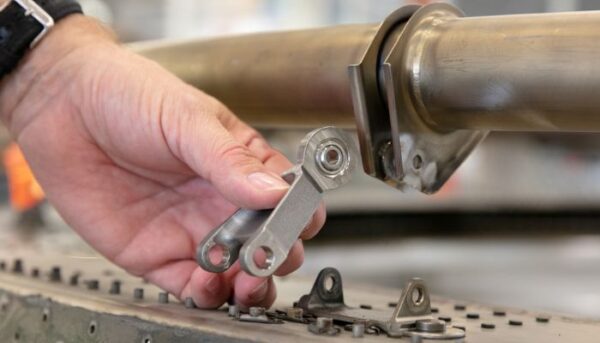
Thanks to additive manufacturing, quite a few major successes and improvements have already been celebrated in the aerospace sector. Now, German airline Lufthansa has announced that, in a joint collaboration with Premium AEROTEC, additive manufacturing will be used for more cost-effective production of spare parts for their aircraft . Specifically, the metal component produced at Lufthansa Technik’s Additive Manufacturing Center will be used for the IAE-V2500 engine’s anti-icing system. For this, the two companies have already received official aviation approval from the European Aviation Safety Agency (EASA) for the additively manufactured A-Links. This is the first instance where approval has been given within the aerospace industry for a load-bearing, metallic, 3D printed spare part.
With the support of Premium AEROTEC, Lufthansa is positioning itself very well, because as a global player within the aviation industry, Premium AEROTEC specializes in the development and production of aircraft parts made of metal and carbon fiber composites. Lufthansa Technik needs a total of nine of these so-called A-links to fix a ring-shaped hot air duct in the engine’s inlet cowl. This prevents the formation of ice on the aircraft engine, which is also urgently required due to the enormous altitude of an aircraft. Though they are extremely important, they often wear down at their mounting holes, meaning they need to be replaced every few years.

The 3D-printed A-Link (photo credits: Premium AEROTEC)
Low Wear and Cost Reduction: Lufthansa Enjoys the Advantages of Metal Additive Manufacturing
The main reason why 3D printing was chosen for the production of the A-Links is primarily related to wear and tear. The traditionally manufactured A-Links can no longer be used under all given safety aspects after only a few years due to the vibrations during a flight and have to be replaced. Though usually such aircraft parts are made with a forging process, the German airline will now be able to produce them by Laser Powder Bed Fusion (LPBF) thanks to collaboration with Premium AEROTEC. Compared to the forging process, this has the advantage that no jigs or molds are required for subsequent production, resulting in valuable material savings and thus cost reductions.
However, in order to finally obtain approval from the EASA using additive manufacturing, a number of tests had to be carried out in advance with the 3D-printed parts; especially since their properties depend heavily on the additive manufacturing process in question. Therefore, Premium AEROTEC performed a large number of print jobs with prototypes, all of which had constantly set process-relevant parameters. The result: a successful and reliable printing process could be generated and proven, which also achieves the highest material property requirements. Particularly with regard to the tensile strength of the additively produced A-Link, this is even superior to the original part.

The additively manufactured A-link is attached to the IAE-V2500 anti-icing system (photo credits: Lufthansa)
It is obvious that the cooperation between Lufthansa and Premium AEROTEC has brought significant benefits for both sides: Lufthansa has now expanded the expertise of its EASA Part 21/J development facility to include additively manufactured metal components as part of the certification process. For Premium AEROTEC, on the other hand, the partnership with Lufthansa is a particular success, as it is now the first time that it has supplied 3D printed parts to a customer outside the Airbus Group. Dr. Ulrich Weber, Chief Operating Officer at Premium AEROTEC is delighted with the cooperation: “I am very pleased that in cooperation with Lufthansa Technik we can now once again demonstrate our comprehensive expertise in 3D printing.” Soeren Stark, Lufthansa’s Chief Technical Officer, is also happy about the benefits this partnership brings, he commented “We have been producing components for the aircraft cabin, the vast majority of which are made of plastic, using 3D printing for years. Now we are able to demonstrate that structurally relevant metal parts for use outside the cabin can also be manufactured additively and approved for flight operations. In this way, we have not only achieved a cost saving for the component in question, but also defined and qualified all the necessary processes for the application of this groundbreaking manufacturing method for structurally relevant metal parts.”
Future plans of Lufthansa and Premium AEROTEC
However, this is only the first step for the two companies. They are already planning future uses of additive manufacturing to specifically optimize geometries. Especially since the shaping of additively manufactured components knows no limits, they want to expand this advantage even further. If you would like to learn more about the project of Lufthansa and Premium AEROTEC, please click here HERE.

Photo Credits: Lufthansa Technik
*Cover Photo Credits: Lufthansa


